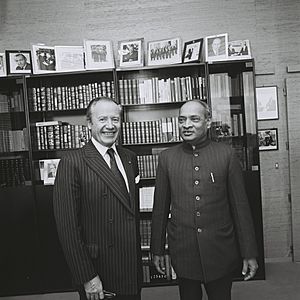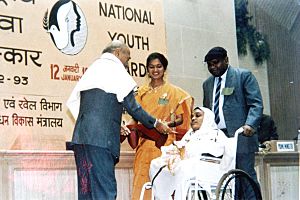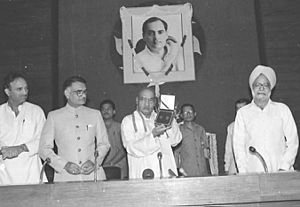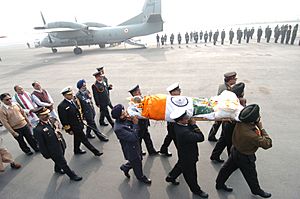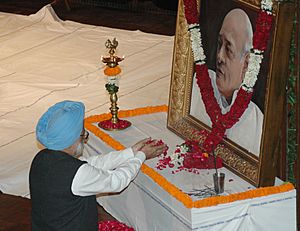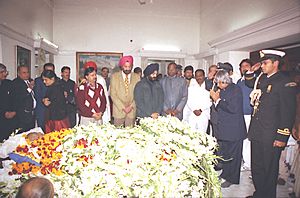P. V. Narasimha Rao facts for kids
Quick facts for kids
P. V. Narasimha Rao
|
|
|---|---|
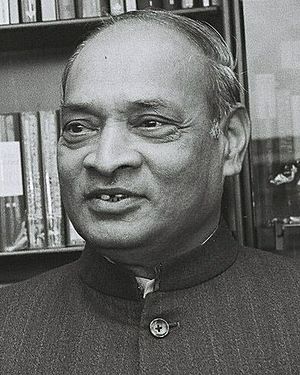
Rao in 1983
|
|
| 9th Prime Minister of India | |
| In office 21 June 1991 – 16 May 1996 |
|
| President | |
| Preceded by | Chandra Shekhar |
| Succeeded by | Atal Bihari Vajpayee |
| Minister of Defence | |
| In office 6 March 1993 – 16 May 1996 |
|
| Prime Minister | Himself |
| Preceded by | Shankarrao Chavan |
| Succeeded by | Pramod Mahajan |
| In office 31 December 1984 – 25 September 1985 |
|
| Prime Minister | Rajiv Gandhi |
| Preceded by | Rajiv Gandhi |
| Succeeded by | Shankarrao Chavan |
| Minister of External Affairs | |
| In office 31 March 1992 – 18 January 1994 |
|
| Prime Minister | Himself |
| Preceded by | Madhavsinh Solanki |
| Succeeded by | Dinesh Singh |
| In office 25 June 1988 – 2 December 1989 |
|
| Prime Minister | Rajiv Gandhi |
| Preceded by | Rajiv Gandhi |
| Succeeded by | V. P. Singh |
| In office 14 January 1980 – 19 July 1984 |
|
| Prime Minister | Indira Gandhi |
| Preceded by | Shyam Nandan Prasad Mishra |
| Succeeded by | Indira Gandhi |
| Minister of Home Affairs | |
| In office 12 March 1986 – 12 May 1986 |
|
| Prime Minister | Rajiv Gandhi |
| Preceded by | Shankarrao Chavan |
| Succeeded by | Sardar Buta Singh |
| In office 19 July 1984 – 31 December 1984 |
|
| Prime Minister |
|
| Preceded by | Prakash Chandra Sethi |
| Succeeded by | Shankarrao Chavan |
| 4th Chief Minister of United Andhra Pradesh | |
| In office 30 September 1971 – 10 January 1973 |
|
| Governor | Khandubhai Kasanji Desai |
| Preceded by | Kasu Brahmananda Reddy |
| Succeeded by | President's rule |
| Member of Parliament, Lok Sabha | |
| In office 15 May 1996 – 4 December 1997 |
|
| Preceded by | Gopinath Gajapati |
| Succeeded by | Jayanti Patnaik |
| Constituency | Brahmapur |
| In office 20 June 1991 – 10 May 1996 |
|
| Preceded by | Gangula Prathapa Reddy |
| Succeeded by | Bhuma Nagi Reddy |
| Constituency | Nandyal |
| In office 31 December 1984 – 13 March 1991 |
|
| Preceded by | Barve Jatiram Chitaram |
| Succeeded by | Tejsinghrao Bhosle |
| Constituency | Ramtek |
| In office 23 March 1977 – 31 December 1984 |
|
| Preceded by | Constituency established |
| Succeeded by | Chendupatla Janga Reddy |
| Constituency | Hanamkonda |
| Personal details | |
| Born | 28 June 1921 Laknepalli, Hyderabad State, British India (present-day Telangana, India) |
| Died | 23 December 2004 (aged 83) New Delhi, Delhi, India |
| Political party | Indian National Congress |
| Spouse |
Satyamma
(m. 1931; died 1970) |
| Children | 8, including P. V. Rajeshwar and Surabhi Vani Devi |
| Alma mater |
|
| Occupation |
|
Pamulaparthi Venkata Narasimha Rao (born June 28, 1921 – died December 23, 2004), known as P. V. Narasimha Rao, was an Indian lawyer and politician. He served as the 9th Prime Minister of India from 1991 to 1996. He is famous for bringing big changes to India's economy. These changes helped India become more open to the world.
Rao was important because he was the first Prime Minister from South India. He led a government that made major economic improvements. He also handled many important national security events. He was in charge of the Industries department. He helped remove the "Licence Raj," which was a system of strict government rules for businesses. This changed India's economic policies.
Later Prime Ministers, like Atal Bihari Vajpayee and Manmohan Singh, continued his economic reforms. Rao chose Manmohan Singh as his Finance Minister. Together, they started India's globalization efforts. These efforts followed International Monetary Fund (IMF) ideas to save India from an economic crisis. Rao was sometimes called Chanakya because he was skilled at passing laws. He did this even though his government did not have a clear majority.
A. P. J. Abdul Kalam, who later became India's 11th President, called Rao a "patriotic statesman." Kalam said Rao believed the country was more important than politics. Rao also asked Kalam to prepare for nuclear weapons tests in 1996. However, these tests happened later in 1998 under the Vajpayee government. Rao had shared information about the nuclear test preparations with Vajpayee.
Rao's time as Prime Minister was very important for India. His government changed India from a mixed economy to a market-driven one. During his time, the Bharatiya Janata Party (BJP) also grew stronger. Rao passed away in 2004 from a heart attack in New Delhi. He was cremated in Hyderabad.
He was a very smart person with many interests. Besides politics, he loved literature and computer software. He could speak 17 languages! Even though some people criticized him, many now see him as one of India's best Prime Ministers. He helped India through the 1991 economic crisis. He also started diplomatic relations with Israel. He began India's Look East policy. He also restarted India's nuclear program. He successfully dealt with insurgency in Punjab and terrorism in Kashmir. He also opened some diplomatic relations with Taiwan.
Contents
Early Life and Education
P. V. Narasimha Rao was born on June 28, 1921. He was born in a Telugu Niyogi Brahmin family. This was in the village of Laknepalli in Warangal district, which is now part of Telangana. His parents were Sitarama Rao and Rukma Bai. Later, he was adopted by Pamulaparthi Ranga Rao and Rukminamma. He moved to Vangara when he was three years old.
He started his primary education in Katkuru village. He then studied for his bachelor's degree at Osmania University. P. V. Narasimha Rao was part of the Vande Mataram movement in the late 1930s. This movement was in the Hyderabad State. He later earned a master's degree in law from Nagpur University. He also completed his law studies at Fergusson College in Pune. This college was part of the University of Bombay (now Mumbai).
In the 1940s, P. V. Rao helped edit a Telugu weekly magazine. It was called Kakatiya Patrika. He wrote articles for it using the pen-name Jaya-Vijaya. He also served as the Chairman of the Telugu Academy in Andhra Pradesh from 1968 to 1974.
Political Journey
Rao was a freedom fighter during the Indian independence movement. After India became independent, he joined politics full-time. He became a member of the Indian National Congress. He was elected to the Andhra Pradesh State Assembly from 1957 to 1977. He held various minister positions in the Andhra government from 1962 to 1973.
In 1971, he became the Chief minister of Andhra Pradesh. He brought in strict land reforms. He also made sure that lower castes had reservations in politics. He supported Indira Gandhi when she formed the New Congress party in 1969. This party later became Congress (I) in 1978.
He served as a Member of Parliament from Andhra Pradesh. He became well-known for handling many important jobs. These included Home, Defence, and Foreign Affairs. He worked in the cabinets of both Indira Gandhi and Rajiv Gandhi. He was the Foreign Minister from 1980 to 1984 and again from 1988 to 1989.
Rao almost retired from politics in 1991. But the assassination of Rajiv Gandhi made him return. The Congress party won the most seats in the 1991 elections. This gave him the chance to become Prime Minister. He was the first Prime Minister outside the Nehru–Gandhi family to serve for five years. He was also the first from the State of Andhra Pradesh and South India.
Since Rao had not run in the general elections, he had to win a special election. He won from Nandyal by a huge margin. His victory was even recorded in the Guinness World Records. Later, in 1996, he was a Member of Parliament from Berhampur, Odisha.
He chose Manmohan Singh, an economist, as his Finance Minister. This was unusual because Manmohan Singh was not a career politician. He also sent opposition leader Atal Bihari Vajpayee to represent India at a UN meeting. This showed his willingness to work with others.
Narasimha Rao won elections from different parts of India. These included Andhra Pradesh, Maharashtra, and Odisha.
| # | Position | Took Office | Left Office | Constituency | State |
| 1 | Member of Legislative Assembly | 1957 | 1977 | Manthani | Andhra Pradesh |
| 2 | Member of Parliament, Lok Sabha | 1977 | 1980 | Hanamkonda | Andhra Pradesh |
| 3 | Member of Parliament, Lok Sabha | 1980 | 1984 | Hanamkonda | Andhra Pradesh |
| 4 | Member of Parliament, Lok Sabha | 1984 | 1989 | Ramtek | Maharashtra |
| 5 | Member of Parliament, Lok Sabha | 1989 | 1991 | Ramtek | Maharashtra |
| 6 | Member of Parliament, Lok Sabha | 1991 | 1996 | Nandyal | Andhra Pradesh |
| 7 | Member of Parliament, Lok Sabha | 1996 | 1998 | Brahmapur | Odisha |
Prime Minister: 1991-1996
Economic Changes for India
In 1991, India faced a big economic crisis. Rao's government decided to make major changes to the economy. These changes helped open India to foreign investment. They also improved capital markets and reduced government control over businesses. The main goals were to lower government spending and increase investment.
Rao wanted to make India more open to foreign trade. He chose Manmohan Singh, a famous economist, as his Finance Minister. Manmohan Singh played a key role in making these changes happen.
Some of the big economic changes included:
- Removing rules that controlled how many shares companies could issue.
- Giving the SEBI more power to regulate financial markets.
- Allowing foreign investors to invest in India's stock markets.
- Starting the National Stock Exchange of India in 1994. This was a computer-based trading system.
- Lowering taxes on imported goods.
- Encouraging foreign companies to invest in India. They could now own more of a company in joint ventures.
These changes had a big impact. Foreign investment in India grew from $132 million in 1991–92 to $5.3 billion in 1995–96. Rao also reduced the need for government licenses for many industries.
National Security and Foreign Policy
Rao strengthened India's nuclear security and missile programs. These efforts led to the 1998 Pokhran nuclear tests. It is believed that Rao had planned these tests in 1995. He also increased military spending. He prepared the Indian Army to fight terrorism and other threats.
During his time, Sikh terrorism in Punjab was largely stopped. He also handled aircraft hijackings without giving in to terrorist demands. He managed the situation when terrorists occupied the Hazratbal shrine in Jammu and Kashmir in 1993. He ended the occupation peacefully. He also dealt with the kidnapping of foreign tourists in Kashmir in 1995. His policies ensured that the terrorists' demands were not met.
Rao also improved India's relationships with other countries. He opened official relations with Israel in 1992. He also started the Look East foreign policy. This policy brought India closer to countries in Southeast Asia. This helped India in March 1994. At that time, efforts to pass a resolution against India at the UN failed. China and Iran opposed it.
Rao's handling of the 1993 Bombay bombings was praised. He visited Mumbai after the blasts. He then asked intelligence agencies from other countries to examine the evidence.
Leading India's Nuclear Program
Rao played a very important role in India's nuclear program. A. P. J. Abdul Kalam said that Rao told him to be ready for nuclear tests. Rao had prepared the program so that the next Prime Minister could carry out the tests.
Former Prime Minister Atal Bihari Vajpayee said that Rao told him the "bomb was ready." Vajpayee said, "I only exploded it." This shows how much Rao contributed to India's nuclear strength.
Handling Separatist Movements
Rao successfully weakened the Sikh separatist movement. He also managed the Kashmiri separatist movement. He made the important decision to hold elections in Punjab. His government also introduced the Terrorist and Disruptive Activities (Prevention) Act (TADA). This was India's first anti-terrorism law.
Babri Mosque Incident
On December 6, 1992, members of the Vishva Hindu Parishad (VHP) demolished the Babri Mosque in Ayodhya. Many people believe this site is the birthplace of the Hindu god Rama. This event caused widespread violence between Hindus and Muslims across India. Many major cities saw unrest.
A special investigation, the Liberhan Commission, later cleared P. V. Narasimha Rao. It said that Rao's government was a minority government. This meant it had less power. The commission noted that the state government had downplayed the risk. It also said that central forces could not have been sent in without proper reasons.
Latur Earthquake Response
In 1993, a strong earthquake in Latur, Maharashtra, killed many people. It also left hundreds of thousands homeless. Rao was praised for using modern technology to organize relief efforts. He also started plans for economic recovery in the affected areas.
Later Life and Legacy
After the 1996 elections, Rao's Congress Party lost power. He then stepped down as Party President. He was replaced by Sitaram Kesri.
Rao wrote a novel called The Insider. The book was about a man's journey in Indian politics. It was similar to events in Rao's own life.
Even though he held many important positions, he faced financial difficulties. He even asked friends to sell his house to pay his lawyers.
Passing Away
Rao had a heart attack on December 9, 2004. He passed away 14 days later, on December 23, 2004, at the age of 83. His family wanted him to be cremated in Delhi. However, his body was moved to Hyderabad. His funeral was attended by many important people, including Prime Minister Manmohan Singh.
A memorial was built for P. V. Narasimha Rao in Hyderabad. It is called P. V. Gyan Bhoomi. In 2014, the Government of Telangana declared his birthday a state function. In Delhi, a memorial for him was also built at Ekta Sthal. The plaque there describes him as the "scholar Prime Minister of India." It also mentions his ability to speak 15 languages.
Family Life
In 1931, at the age of 10, Narasimha Rao married Satyamma. Their marriage was arranged by their families and was a happy one. Satyamma passed away on July 1, 1970.
They had three sons and five daughters. His eldest son, P. V. Ranga Rao, was an education minister. His second son, P. V. Rajeshwar Rao, was also a Member of Parliament. His third son is P.V. Prabhakara Rao.
Achievements and Recognition
Books and Writings
Rao's first language was Telugu. He also spoke Marathi very well. He could speak 17 languages in total! He translated a famous Telugu book, Veyipadagalu, into Hindi. He also translated a Marathi novel into Telugu.
He wrote his autobiography, The Insider. This book shares his experiences in politics.
Centenary Celebrations
In June 2020, the Government of Telangana announced year-long celebrations for Rao's 100th birthday. The state government also decided to build a memorial and five bronze statues. These statues would be in places like Hyderabad and Delhi.
Awards and Honors
Rao received the Pratibha Murthy Lifetime Achievement Award. Many people believe he should receive the Bharat Ratna, India's highest civilian award. The Chief Minister of Telangana, K. Chandrashekhar Rao, supported this idea.
In September 2020, the Telangana Legislative Assembly asked the Central Government to give Rao the Bharat Ratna. They also asked to rename the University of Hyderabad after him.
Images for kids
See also
 In Spanish: P. V. Narasimha Rao para niños
In Spanish: P. V. Narasimha Rao para niños


